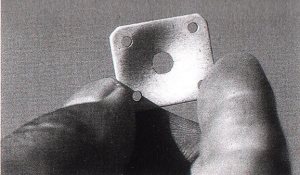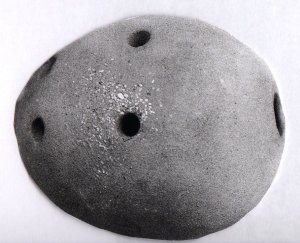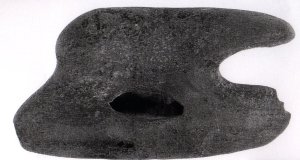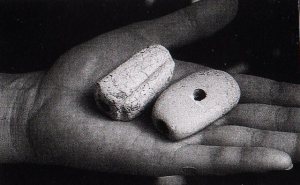
Clay drum excavated from the Nagamine site, Nagano prefecture. Animal skin was stretched over the mouth of the vessel and held by strings that went through the perforated holes around the rim of the mouth.
We know today that the Jomon people lived a tribal village lifestyle during the Jomon period (10,000 – 300BC) with many festivals that had shamanic rituals with dancing and singing.
The sounds of the percussion instrument — the clay drum are thought to have dominated the music and ceremonial scene of the Jomon people. It is thought that the drum power was associated with the gods and that drum beating was used to signal the start of the village hunt or the approach of a storm. The rumbling sounds of the drum persists till today in the taiko drum which remains a very important traditional instrument of the Japanese culture.
Watch a riveting 1995 performance of Toshi Tsuchitori’s at the Saitama Art Center “Jōmonko; Pottery Drums of Jōmon Period(B.C.3000-B.C. 2500)” that recreated the sounds of the Jomon drum on replica Jomon clay drums here:
Besides the drum, the Jomon people also had many kinds of whistles made from deer antler, stone or clay, as well as wooden primitive fiddle-like or koto-like instruments that could be strummed.

A whistle made of deer antler, from the Saka Shellmound, Nagano prefecture. The whistle produces a sound that mimicks the cry of the doe (female deer).

Replica of clay bird-whistle from the Satohama Shellmound, Miyagi prefecture. Two plates were found in the shellmound.
A range of sounds can be produced using the above pictured clay bird-whistle depending on the combination of holes covered. When the two clay plates identical to the one in the photo are affixed by pegs, the blowing upon the whistle produces the sound that mimicks the cry of the Common Pheasant. It is thought that the whistle was used to help in attracting and hunting down the bird.
Below are more excavated finds and replica musical instruments of the Jomon people and period.

A Jomon musical instrument that resembles a tonkori (Ainu traditional instrument) that is said to produce koto-like sounds. Strings are strung through the 4 holes at the tip. Excavated wooden artifact from Matsubaranaiko site, Shiga prefecture
For more on the koto-like (hera- or nogata-shaped instrument), see this page.
Tonal sounds can be produced by covering the holes on the side. See stone whistles below.
Sources:
Jomon-jin no Douki (Vol. 4 Jomon-jin no kurashii) Rekishitaiken
Further information and resources:
A lecture on “Jomon music” (substitled in English) by Toshi Tsuchitori
Origin of the koto and kayagum
Watch another performance of Toshi Tsuchitori’s recreating music on other Jomon instruments such as the ocarina here.
How to make an ocarina (listen to it played)




What tabblo?
You mean a radio button? There is none on this page.
Tabblo refers to the image box, you can click on any part of the image you see, or on the red “see more at tabblo” bar to go to that page for all the images in the “tabblo” page. Tabblo is a server which allows us to create posters that hold many photos or images but you only see a fraction of it until you click on the tabblo to go to the tabblo page.
That instrument on the bottom left corner is similar to an ocarina don’t you think?
You are quite right. The ocarina connection http://en.wikipedia.org/wiki/Ocarina has been noted – some of the most ancient prototype ocarinas are whistles (or vessel flutes) found in China (at least 7,000 years BP): India (5,000 years ago) but intriguingly the oldest are thought to be clay whistles from the Mayan civilization (http://www.fl-oca.com/eng/ocarina2.htm) 12,000 years ago. The Chinese egg-shaped early version of Xun is similar to the Japanese Jomon whistle which come in stone and clay versions (clay versions are found in the Yayoi period too) which suggests a possible continental origin (or vice versa). Since the ancient ocarina can be found in among the ancient Mesoamericans and Native Americans (the modern ocarina is based on the Aztec version of the ocarina that was introduced to Europe following their Aztec invasion) it is highly probable that the stone or clay ocarina was an invention of the earliest East Asian(or Siberian/Central Asian) migrants who crossed over to the Americas. Genetic connections between the earliest Jomon populations and Siberian or Central Asian/Northern Chinese, as well as Native Americans or Mesoamericans have been established, so the spread of the instrument fits well within this picture and time-frame. Source: Ocarina: http://www.dulcimershofar.com/Ocarina-sp-27.html / The ocarina and tsuchibue are Japanese traditional instruments that have continuity and that are still taught to children and played in Japan today: http://ci.nii.ac.jp/naid/110000119603
The Tabblo page no longer exists. On another note, here’s a link to some Jomon era stringed instruments. http://cgi.daily-tohoku.co.jp/cgi-bin/news/2012/03/22/new1203221601.htm The instruments are from the final Jomon period around 3000 years ago. The overall shape is reminiscent of the Tonkori.
Thanks for the Tohoku Daily article link which I have now translated into English. Also I have re-uploaded the original photos that were on Tabblo, and so have updated this page.
Am hearing of these Musical Instruments today. Atleast i have learn something new on what you have shared.